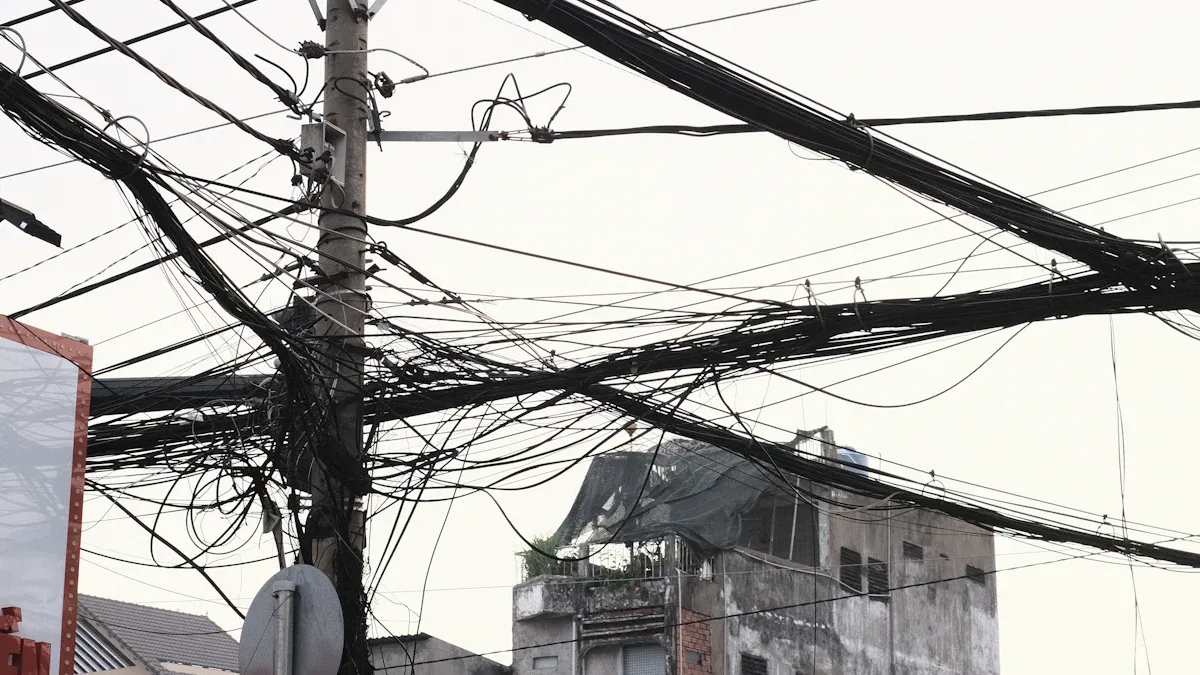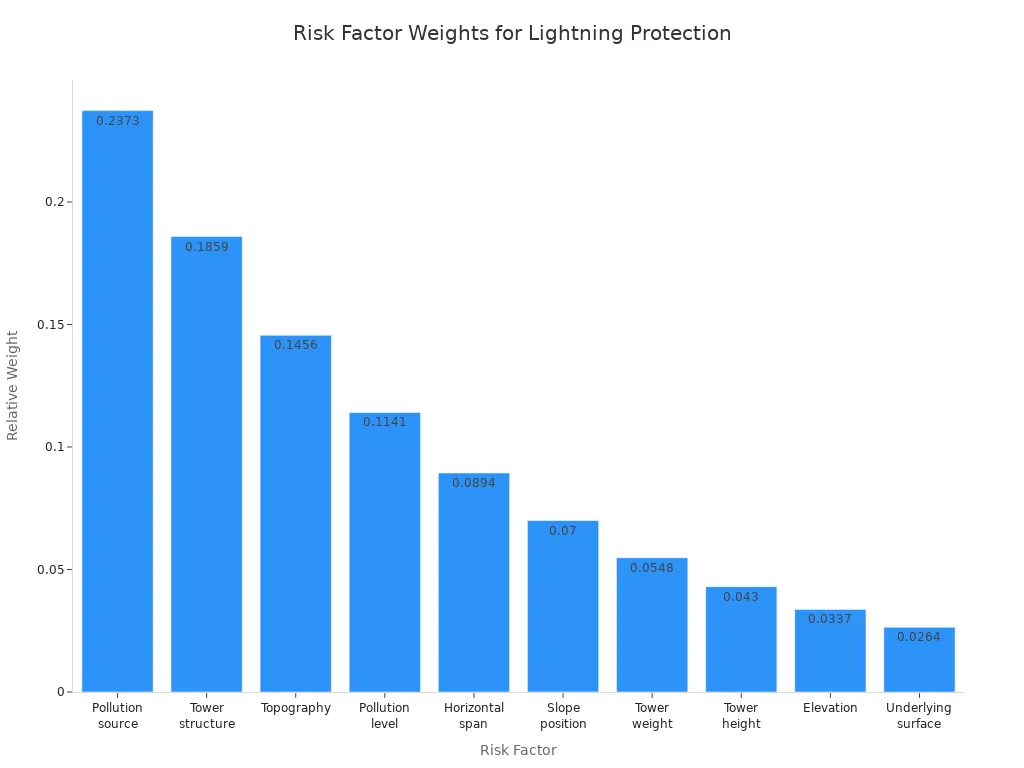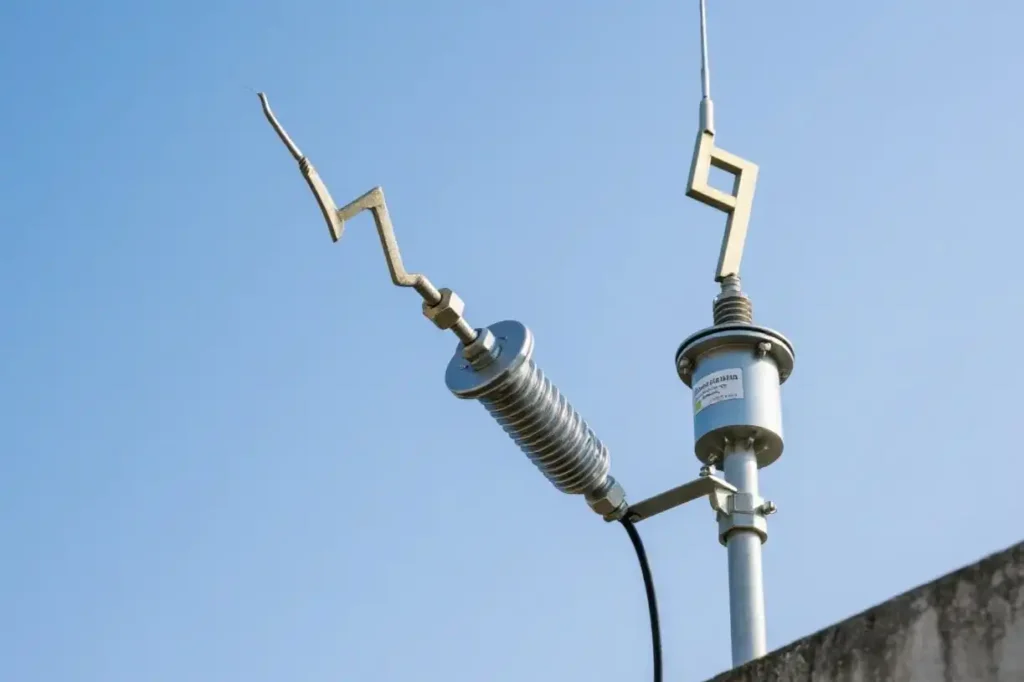Lightning protection devices in 2025 use new technology. They have smarter integration and stronger materials. These things help keep buildings safe. Recent numbers show fewer insurance claims for lightning damage in the U.S.:
| Metric | Value (2024) | Change from 2023 |
|---|---|---|
| Total insurance claims paid | $1.04 billion | -16.5% |
| Number of claims | 55,537 | -21.5% |
| Average cost per claim (national) | $18,641 | +6.4% |
Good design and installation of these systems are important. When people follow standards like NFPA 780, there is less damage. Homes and businesses also have less downtime.
Key Takeaways
- Advanced lightning protection devices have smart sensors and tough materials. These help keep buildings safer and make them last longer.
- Smart monitoring and surge suppression can spot lightning early. They also protect equipment from getting damaged.
- Following new safety standards like NFPA 780 is important. Doing regular maintenance makes sure systems work well and follow the law.
- Picking the right system depends on building size, use, place, and budget. This helps get the best protection.
- Experts should install the system and check it often. This helps lightning protection devices work better and saves money over time.
Innovations in Lightning Protection Devices
Smart Monitoring
Smart monitoring has made lightning protection better in 2025. These systems use sensors and IoT technology to watch for lightning right away. Operators can check the data from far away. They get alerts if lightning is close or if the system needs fixing.
- Watching in real time helps find problems fast.
- People can check systems quickly, even in tough spots.
- Smart sensors use magnetic direction finding and time-of-arrival to find lightning.
- Fewer sensors are needed, so it costs less to cover big areas.
Smart monitoring warns building owners early. This helps them act fast to keep people and equipment safe.
Groups like the U.S. National Weather Service use these systems to track lightning. The information also helps plan for future storms and manage risks.
Advanced Materials
New materials make lightning protection devices stronger and last longer. In 2025, companies use advanced alloys, carbon fiber, and special composites. These materials carry electricity better than old metals. They are lighter, which helps wind turbines and airplanes.
Tungsten alloys can take a lot of heat and many lightning hits. Composite materials, like metal meshes and polymer coatings, fit odd shapes and are easy to fix. These things lower repair costs and help systems last longer.
| Material Type | Key Benefit | Common Use |
|---|---|---|
| Carbon Fiber | Lightweight, strong | Wind turbines, aircraft |
| Tungsten Alloy | High heat resistance | Turbine blades |
| Aluminum Mesh | Good conductivity | Building exteriors |
| Polymer Coatings | Easy repairs, flexible | Complex structures |
Advanced materials protect renewable energy sites and smart city buildings. Many are recyclable and do not rust, which helps the environment.
Surge Suppression
Surge suppression is very important in new lightning protection devices. New surge protection devices (SPDs) follow strict rules like IEC 61643 and NFPA 780. These rules make sure the devices work well and keep people safe.
SPDs come in three main types:
- Type 1 protects against direct lightning at the main entrance.
- Type 2 guards against surges at distribution boards.
- Type 3 shields sensitive equipment where it is used.
Each type has a special job and must go in the right spot. Good grounding and regular checks are needed. Many SPDs have modular designs, so they fit many buildings and can be upgraded.
- SPDs lower the chance of fire and electric shock.
- They help buildings follow local and world codes.
- Yearly checks and post-storm inspections keep systems safe.
Surge suppression protects homes, offices, renewable energy systems, and smart infrastructure.
Safety and Performance
Reliability
Advanced lightning protection devices in 2025 are more reliable. They use sensors to watch for electrical changes and weather. These sensors can find problems early. This helps stop fires or electrical failures before they start. Every year, lightning strikes the U.S. over 25 million times. These strikes cause billions of dollars in damage. Certified systems lower fire risk and protect equipment. They also help lower insurance costs.
Many new devices work before problems happen. Some systems stop lightning from forming by changing electric charges in the air. This protects a bigger area and means fewer devices are needed. These systems last longer because they do not have parts that wear out fast.
A Texas university lost $1.2 million when lightning hit unprotected equipment. Most equipment breaks from small surges, not big strikes. Advanced surge protection helps stop these expensive problems.
Standards Compliance
New standards help make lightning protection devices better. The main rule in North America is NFPA 780. It gets updated every three years. This rule explains how to design, install, and check these systems. The 2024 International Building Code says all lightning protection must follow NFPA 780 or UL 96A.
| Aspect | Details |
|---|---|
| Updated Standard | 2024 International Building Code (IBC) Section 2703 |
| Effective Date | 2024, for 2025 projects |
| Key Requirements | Install per NFPA 780 or UL 96A; UL 96A not for explosive hazard buildings |
| Interconnection | All systems must be interconnected as per standards |
| Emphasis | Proper installation, inspection, and integration with roofing systems |
New rules use better risk checks and need more inspections. This keeps people and property safe. It also makes the systems work better.
Maintenance
Good maintenance keeps lightning protection devices working well. Experts say to check and test systems often. Most buildings need a visual check every year. In places with bad weather, checks should happen every six months. Full inspections, with testing, should happen every two to five years, depending on risk.
| Maintenance Aspect | Recommendation |
|---|---|
| Visual Inspection | Annually; every 6 months in high-risk areas |
| Full Inspection | Every 2–5 years, based on risk |
| Earth Resistance Testing | During extreme seasonal changes |
| Use of Drones | Faster, safer, and more cost-effective checks |
New tools, like drones with sensors, make checks faster and safer. Drones can look at tall buildings and wind turbines. This keeps workers safe. Regular maintenance helps stop failures and keeps the system ready for storms.
Traditional vs. Advanced Devices

Effectiveness
Traditional lightning protection devices have been used for a long time. They help keep buildings safe from lightning. Studies show these systems work well if installed correctly. Advanced devices, like Charge Transfer Systems and Early Streamer Emission air terminals, say they give more protection. But research shows these new devices do not stop lightning better than the old sharp-pointed air terminals. Both types protect about the same area and give similar safety. People should know that new technology does not always work better in this case.
Durability
How long a safety system lasts is important. Traditional lightning protection systems can last 30 to 50 years or even longer. Their life depends on the materials, how they are put in, and regular checks. Power surge protectors are used in both old and new systems. These usually last 8 to 12 years because their parts wear out. Advanced lightning protection devices might last longer because they use better technology and materials. But we do not always know the exact numbers. The table below shows how long different parts can last:
| Device Type | Average Lifespan | Key Factors Affecting Lifespan |
|---|---|---|
| Traditional Lightning Protection System | 30 to 50 years or more | Material quality, installation, weather, maintenance |
| Power Surge Protectors (SPDs) | 8 to 12 years | Component wear, environment |
| Advanced Lightning Protection Devices | Potentially longer | Improved features, technology, but exact data not specified |
Cost-Benefit
Advanced lightning protection devices cost more at first. For big buildings, prices can be from $5,000 to $50,000 or even more. This higher price brings some good things, like better safety and less downtime. Advanced systems use smart technology to check things in real time and help fix problems before they get worse. This can save money on repairs later. They also help buildings follow strict safety rules and keep people safe during storms. Even though the starting cost is high, these systems are a good choice for places with expensive equipment or where safety is very important. More people want these upgrades as cities grow and storms happen more often.
Choosing Lightning Protection Devices
Building Type
Picking the right lightning protection device depends on the building. Big or oddly shaped buildings often need mesh systems or Faraday cages. Small buildings, like houses, might use Franklin rods. Where the building is matters a lot. Places with lots of storms or lightning need stronger protection. Buildings with important electronics, like hospitals or data centers, need both strike and surge protection. Local rules and national standards help people choose the right system.
- The size and shape of a building change the design.
- Local weather and lightning risk affect what is needed.
- What the building is used for can mean extra surge protection.
- Following codes keeps people safe and meets the law.
- Picking good materials, strong grounding, and smart design is important.
The chart below shows how different risks change which protection technology is best:

Budget
How much money you have is a big part of the choice. Home systems usually cost $2,000 to $4,000. Business systems start at $10,000 and can be much more. The price depends on roof size, building height, and what materials are used. Copper costs more than aluminum but lasts longer. Buildings near the ocean may need special materials to stop rust, which costs more. New buildings can save money by adding protection while being built.
| Property Type | Typical Budget Range | Key Cost Influencers |
|---|---|---|
| Residential | $2,000 – $4,000 | Roof size, soil type |
| Commercial | $10,000+ | Height, equipment, materials |
Tip: Some places give money or discounts to help pay for advanced systems, which can make them cheaper.
Installation
Having a pro install the system makes sure it works right. Experts start by checking the building and its risks. They make a custom plan for each building. Good materials and skilled workers keep everyone safe. Air terminals, conductors, and grounding must go in the right spots. Licensed electricians do the work and test the system when done. Keeping up with regular checks helps the system work well during storms.
- Certified workers look at the site and check for risks.
- Custom plans are made for each building.
- Good materials and skilled work keep things safe.
- Testing and paperwork show the system is set up right.
- Regular checks and help keep the system working for years.
Getting regular checks and help from pros makes lightning protection devices last longer and work better.
Advanced systems in 2025 keep people safer and work better. They also make it easier to follow new safety rules. Many real-life stories show upgrades stop expensive damage. They help buildings avoid long shutdowns and protect important equipment. Experts say people should get regular checks and use pros for setup. Homeowners and businesses upgrade to lower risks and meet insurance rules. Upgrades can also make a building worth more.
Trusted groups like UL, NFPA, and LPI help people pick and set up the right system. This gives everyone peace of mind for a long time.
FAQ
What makes advanced lightning protection devices different from older systems?
Advanced devices have smart sensors and stronger materials. They can watch for problems in real time. These features help keep buildings safer. They also follow new safety rules. Advanced devices last longer than old ones.
What types of buildings need advanced lightning protection the most?
Hospitals and data centers need strong protection. Tall business buildings need it too. These places have important equipment. They also have more risk from lightning. Good systems help stop damage and keep people safe.
What should building owners check during maintenance?
Owners should look for loose wires and broken parts. They should check for rust or other damage. Regular checks help the system work well. Many experts use drones to check hard-to-reach places.
What standards guide lightning protection device installation in 2025?
NFPA 780 and UL 96A are the main rules. The 2024 International Building Code uses these standards too. Following these rules keeps buildings safe and legal.
See also
What Is a Lightning Protection System and How Does It Work
Surge protection device for solar panels stops lightning damage fast
EV type residual current device
What Are the Main Features of Level 1 and Level 2 Lightning Protection
The 10 Best Automatic Conversion Switch Brands of 2025



